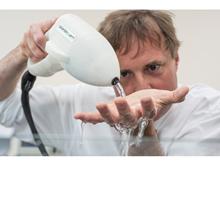The use of acoustic inversion to estimate the bubble size distribution in pipelines

New research from the University of Southampton has devised a new method to more accurately measure gas bubbles in pipelines.
The ability to measure gas bubbles in pipelines is vital to the manufacturing, power and petrochemical industries. In the case of harvesting petrochemicals from the seabed, warning of bubbles present in the crude that is being harvested is crucial because otherwise when these bubbles are brought up from the seabed (where pressure is very high) to the surface where the rig is, the reduction in pressure causes these bubbles to expand and causes ‘blow out'. A blow out is the sudden release of oil and/or gas from a well and issues with the blow out preventer were key in Deepwater Horizon oil spill (also known as the Macondo blowout) in the Gulf of Mexico in 2010.
Currently, the most popular technique for estimating the gas bubble size distribution (BSD) is to send sound waves through the bubble liquid and compare the measured attenuation of the sound wave (loss in amplitude as it propagates) with that predicted by theory.
The key problem is that the theory assumes that the bubbles exist in an infinite body of liquid. If in fact the bubbles are in a pipe, then the assumptions of the theory do not match the conditions of the experiment. That could lead to errors in the estimation of the bubble population.
Now, a team led by Professor Tim Leighton from the Institute of Sound and Vibration Research at the University of Southampton, has devised a new method, which takes into account that bubbles exist in a pipe. Professor Leighton and his team (Post-doctoral research fellows Kyungmin Baik and Jian Jiang) were commissioned to undertake the work as part of an ongoing programme to devise ways of more accurately estimating the BSD for the mercury-filled steel pipelines of the target test facility (TTF) of the $1.4 billion Spallation Neutron Source (SNS) at Oak Ridge National Laboratory, Tennessee, USA one of the most powerful pulsed neutron sources in the world (www.sns.gov).
The research, which is presented in the Royal Society journal ‘Proceedings of the Royal Society A', explores how measured phase speeds and attenuations in bubbly liquid in a pipe might be inverted to estimate the BSD (which was independently measured using an optical technique). This new technique, appropriate for pipelines such as TTF, gives good BSD estimations if the frequency range is sufficiently broad.
Professor Leighton says: "The SNS facility was built with the expectation that every so often it would need to be shut down and the now highly radioactive container of the mercury replaced by a new one, because its steel embrittles from radiation damage. However, because the proton beam impacts the mercury and generates shock waves, which cause cavitation bubbles to collapse in the mercury and erode the steel, the replacement may need to be more often than originally planned at full operating power. Indeed, achieving full design power is in jeopardy.
"With downtime associated with unplanned container replacement worth around $12 million, engineers at the facility are considering introducing helium bubbles, of the correct size and number, into the mercury to help absorb the shock waves before they hit the wall, so that the cavitation bubbles do not erode the steel. Oak Ridge National Laboratory (ORNL) and the Science and Facilities Research Council (Rutherford Appleton Laboratory, RAL) commissioned us as part of their programme to devise instruments to check that their bubble generators can deliver the correct number and size of bubbles to the location where they will protect the pipelines from erosion.
"This paper reports on the method we devised half-way through the research contract. It works, but just after we designed it the 2008 global financial crash occurred, and funds were no longer available to build the device into the mercury pipelines of ORNL. A more affordable solution had to be found, which is what we are now working on. The original design has been put on hold for when the world is in a healthier financial state. This has been a fantastic opportunity to work with nuclear scientists and engineers from ORNL and RAL."
Related Staff Member
Detecting leaks from undersea gas pipelines
An invention that is 100x more sensitive than commercial systems for detecting leaks from undersea gas pipelines
Find out moreBubble acoustics are having an impact
Pioneering research into bubble acoustics is developing exciting applications in several fields.
Find out moreNotes for editors
1. The 1.4 billion dollar Spallation Neutron Source (SNS) at Oak Ridge National Laboratory (ORNL), Tennessee, is the most powerful pulsed neutron source in the world. It fires a beam of protons using a linear accelerator hundreds of metres long, into 20 tonnes of pumped liquid mercury. Specialised neutron instruments (funded by the U. S. Department of Energy and other institutes) are built in a circle around the source to catch the beams of neutrons and use them to probe the internal structures of materials, such as test aircraft wings, forensic samples and biomedical products.
2. The University of Southampton is celebrating its 60th anniversary during 2012.
Her Majesty Queen Elizabeth II, granted the Royal Charter that enabled the University of Southampton to award its own degrees in the early weeks of her reign in 1952
In the six decades to follow, Southampton has risen to become one of the leading universities in the UK with a global reputation for innovation through academic excellence and world-leading research.
This year, the University’s reputation continues to grow with the recent awarding of a Queen’s Anniversary Prize for Higher and Further Education in recognition of Southampton’s long-standing expertise in performance sports engineering.
To find out more visit www.southampton.ac.uk/60
For further information contact:
Glenn Harris, Media Relations, University of Southampton, Tel: 023 8059 3212, email: G.Harris@soton.ac.uk
www.soton.ac.uk/mediacentre/
Follow us on twitter: http://twitter.com/unisouthampton
Like us on Facebook: www.facebook.com/unisouthampton
